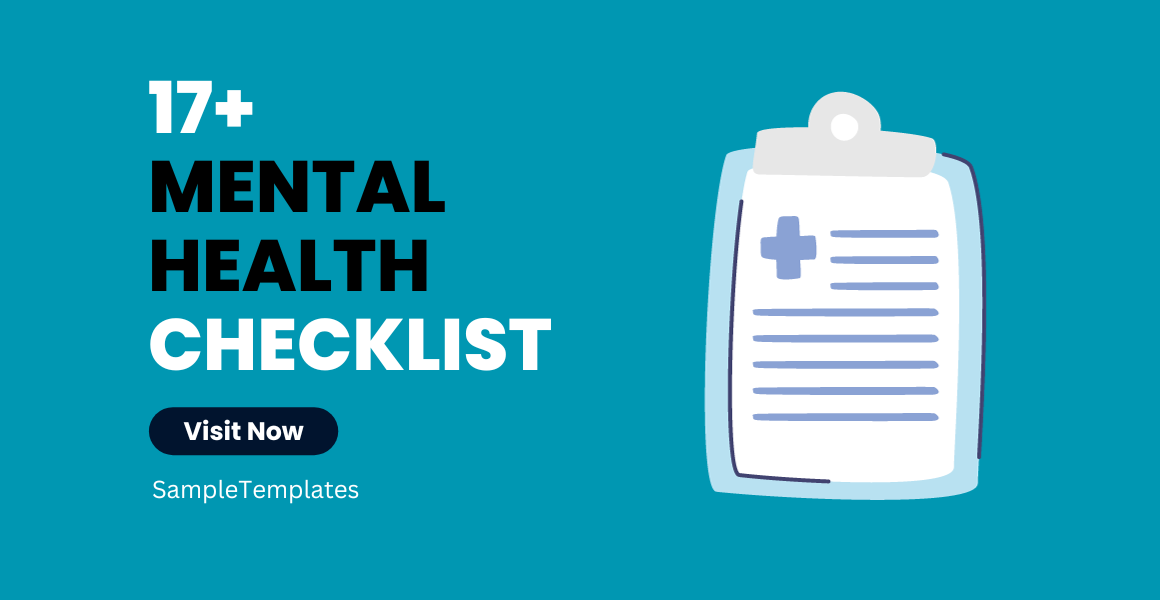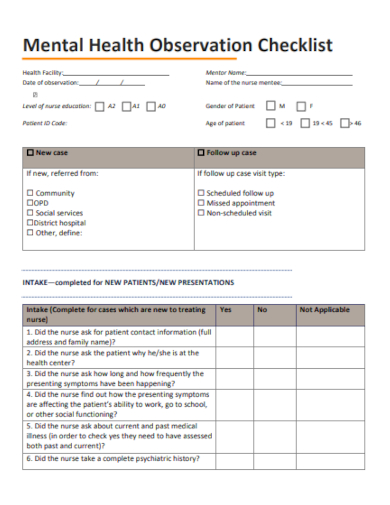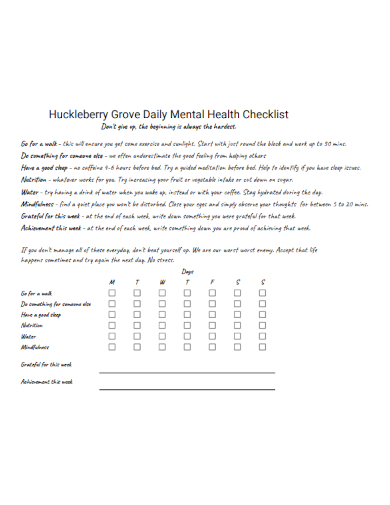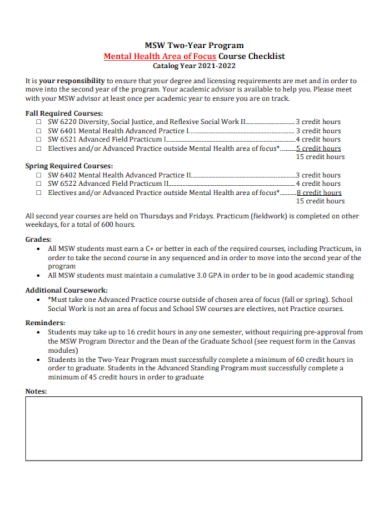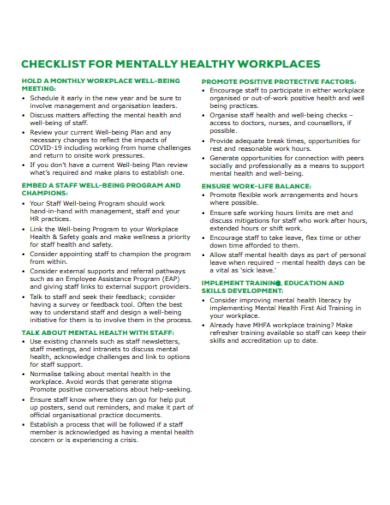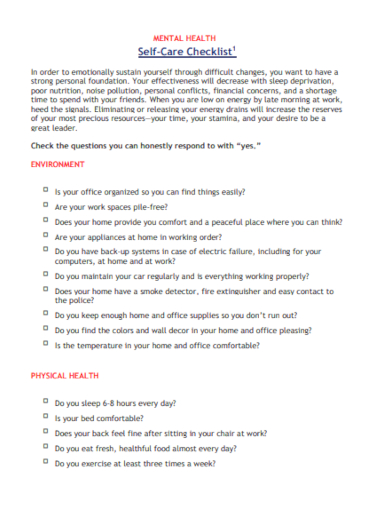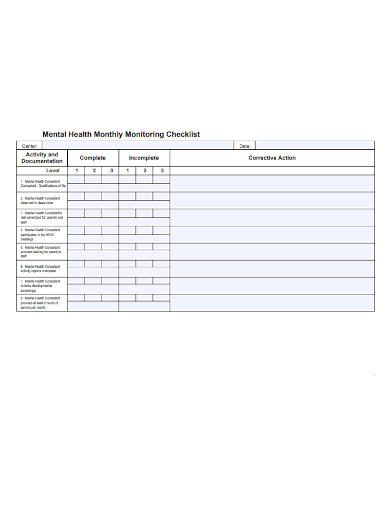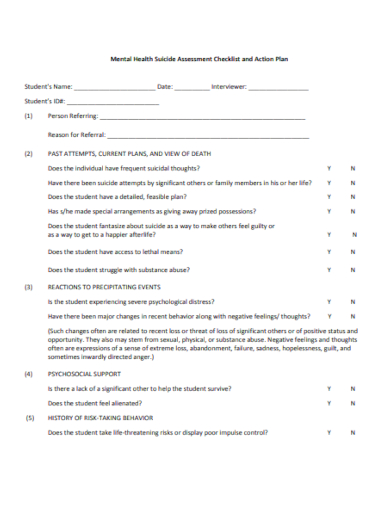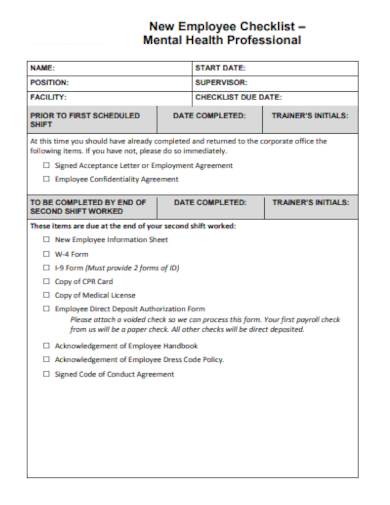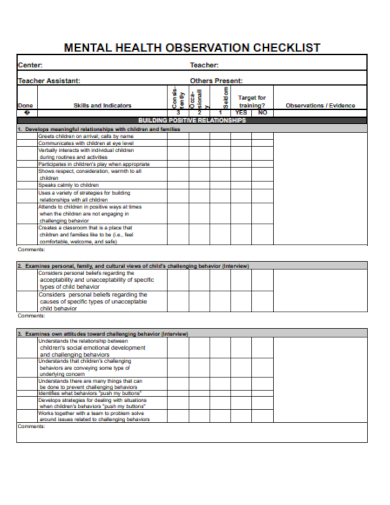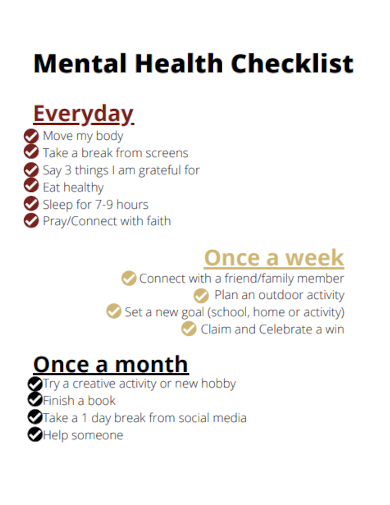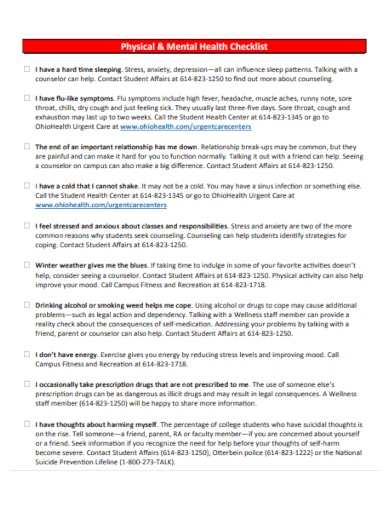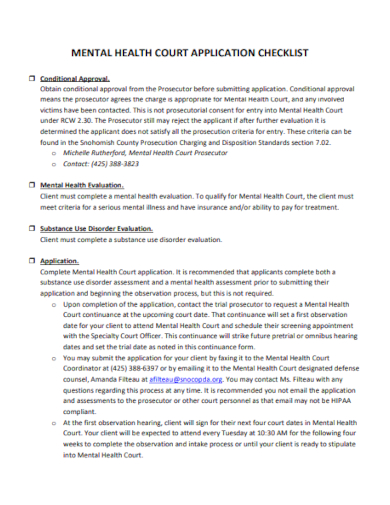In today’s fast-paced world, prioritizing mental well-being is paramount. Our Mental Health Checklist serves as a comprehensive guide, highlighting pivotal steps to cultivate mental resilience. Harnessing insights from top experts, this checklist ensures you’re equipped with actionable strategies, fostering a balanced mindset. Delve into this invaluable resource, tailor-made for individuals seeking clarity and holistic mental wellness in our complex times.
17+ Mental Health Checklist Samples
1. Sample Checklist Template
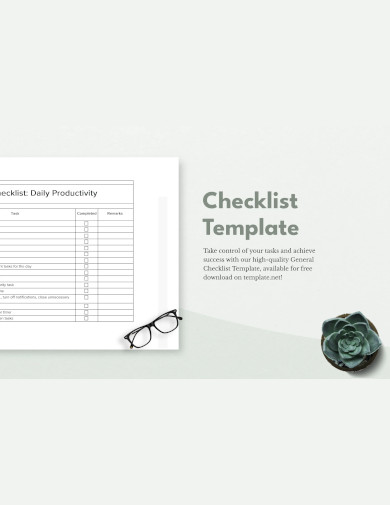
2. Basic Checklist Template
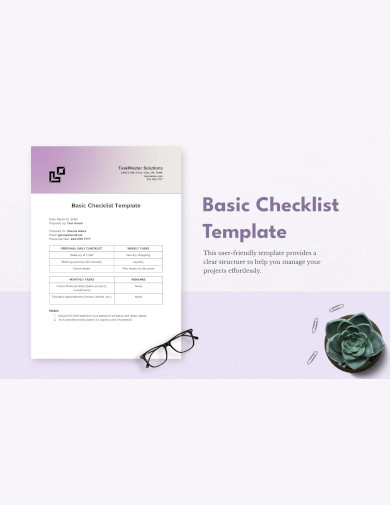
3. Formal Checklist Template
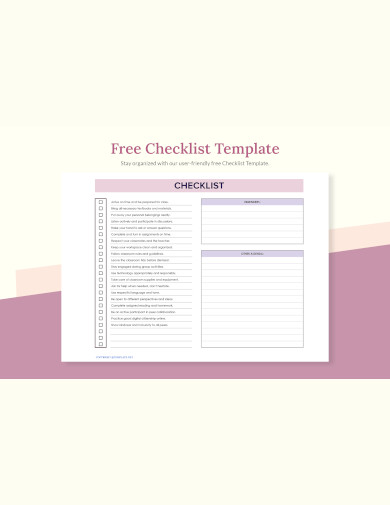
4. Printable Checklist Template
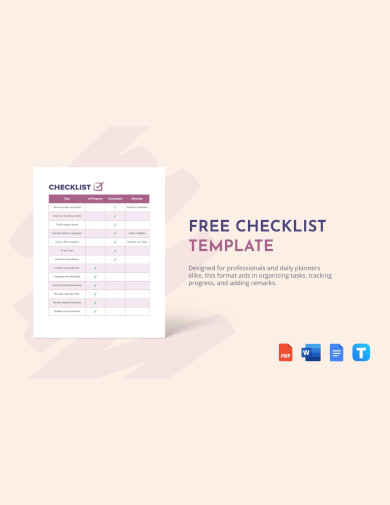
5. Mental Health Observation Checklist
What is a Mental Health Checklist?
Mental health is a critical aspect of overall well-being, encompassing our emotional, psychological evaluation, and social wellness. It affects our thoughts, feelings, and actions, influencing how we handle stress, relate to others, and make choices. Positive mental health contributes to our ability to cope with adversity, work productively, and realize our full potential.
Components of a Mental Health Checklist
- Self-Assessment: Regular self-reflection on thoughts, feelings, and behaviors can help identify patterns and triggers, enabling timely intervention when needed.
- Mood Tracking: Recording daily moods provides insight into emotional fluctuations and helps identify patterns or recurring stressors that may require attention.
- Physical Well-being: Monitoring sleep, nutrition, and exercise is essential as they significantly impact mental health.
- Mindfulness and Relaxation Techniques: Incorporating mindfulness, meditation, or relaxation exercises helps in reducing stress and improving mental well-being.
- Social Connections: Maintaining strong, supportive relationships is crucial for mental health. Regularly connecting with friends, family, or support groups provides a sense of belonging and support.
Utilizing the Checklist
- Daily Reflection: Use the printable checklist daily to reflect on your mental state and identify any areas of concern.
- Setting Goals: Establish achievable goals for areas that need improvement, whether it’s incorporating more physical activity or practicing mindfulness.
- Seeking Support: If the checklist indicates persistent issues or distress, don’t hesitate to seek professional support or talk to someone you trust.
Benefits of a Mental Health Checklist
Proactive Mental Health Management
A mental health checklist operates as a cornerstone for proactive mental health management. It prompts individuals to assess their emotional state regularly, allowing for early detection of any signs of mental distress. This early recognition is pivotal, enabling timely interventions and reducing the risk of issues escalating into more severe mental health conditions.
Enhanced Self-Awareness
One of the most salient benefits of using a mental health checklist is the enhancement of self-awareness. By routinely evaluating one’s thoughts, feelings, and behaviors, individuals can identify patterns, triggers, and areas that require attention. This increased awareness is instrumental in fostering a deeper understanding of one’s mental health, paving the way for informed choices and personalized coping strategies.
Empowerment and Autonomy
Implementing a mental health checklist instills a sense of empowerment and autonomy over one’s well-being. It serves as a daily reminder that mental health is a priority, encouraging individuals to take control and actively engage in practices that promote mental balance and resilience. This empowerment fosters a sense of agency, reinforcing the belief that individuals have the ability to influence their mental health positively.
Promotion of Healthy Habits
Regular use of a mental health checklist promotes the adoption of healthy habits. It encourages mindfulness, strategy of stress management, regular physical activity, and nutritious eating, all of which are fundamental to mental well-being. These habits, once integrated into daily life, contribute to a holistic approach to health, enhancing both mental and physical wellness.
Strengthening Social Connections
A mental health checklist often includes a component focused on social connections, emphasizing the importance of nurturing relationships. Strong, supportive social networks are integral to mental health, providing a sense of belonging and a safety net during times of stress. Fostering these connections enhances emotional support and contributes to a more balanced and fulfilling life.
Goal Setting and Personal Development
Utilizing a mental health checklist facilitates goal setting and personal development. By identifying areas that need improvement, individuals can set achievable, meaningful goals that contribute to mental well-being. This process of goal setting and achievement fosters a sense of accomplishment and progress, promoting personal growth and development.
Facilitating Professional Support
Lastly, a mental health checklist serves as a gateway to professional support when needed. If persistent issues or distress are identified through the checklist, it encourages seeking help, thereby reducing barriers to accessing mental health services. This facilitation is crucial, ensuring that individuals receive appropriate support and intervention when necessary. You can also see more on Health and Safety Checklists.
6. Daily Mental Health Checklist
7. School Mental Health Checklist
8. Workplace Mental Health Checklist
9. Self Care Mental Health Checklist
10. Weekly Mental Health Checklist
11. Mental Health Monthly Checklist
12. Student Mental Health Checklist
13. New Employee Mental Health Checklist
14. Teacher Mental Health Checklist
15. Everyday Mental Health Checklist
16. Physical and Mental Health Checklist
17. Mental Health Application Checklist
18. Mental Health Program Checklist
How do you Create a Mental Health Checklist?
Creating a Mental Health Checklist is a positive step towards fostering well-being and maintaining balance in one’s life. This checklist aims to help individuals identify stressors, manage emotions, and build resilience. Here’s how you can create a personalized Mental Health Checklist in five thoughtful steps:
Step 1: Reflect on Your Needs
Start by reflecting on your unique needs and challenges. Consider what aspects of your mental health need attention and what triggers stress, anxiety, or other negative emotions. For example, you might identify that a balanced diet, regular physical activity, and adequate sleep are fundamental needs that significantly impact your mental well-being.
Step 2: Identify Healthy Coping Mechanisms
Once you have a clear understanding of your needs, identify healthy coping mechanisms that work for you. These could include mindfulness, meditation, deep breathing exercises, or engaging in hobbies and activities that bring you joy and relaxation. For instance, if you find nature calming, you might include regular walks in a nearby park as a coping mechanism.
Step 3: Set Realistic Goals
With your coping mechanisms in mind, set achievable and meaningful goals that promote your mental well-being. Ensure that these goals are SMART – Specific, Measurable, Achievable, Relevant, and Time-bound. An example could be practicing mindfulness meditation for 10 minutes every morning for a month, gradually increasing the time as you become more comfortable with the practice.
Step 4: Establish a Support System
A strong support system is crucial for maintaining mental health. List down friends, family, therapists, or support groups you can reach out to when facing challenges. Having someone to talk to can provide relief and perspective, offering validation and support. Ensure your support system is diverse to help you cope with different aspects of mental health.
Step 5: Monitor Progress and Adjust Accordingly
Lastly, regularly assess your progress and make any necessary adjustments to your checklist. Reflect on what is working and what isn’t, and modify your strategies accordingly. For example, if you find that a specific type of meditation isn’t helpful, try a different style or explore other relaxation techniques.
What is the Mental Health Checklist in Psychology?
In psychology, a Mental Health Checklist can refer to a tool or sample form containing a list of items or criteria used to identify, assess, or monitor an individual’s mental health status. This checklist might include questions or statements related to mood, thoughts, behavior, and daily functioning, with the goal of identifying possible mental health issues or disorders.
In Conclusion, Creating a Mental Health Checklist is a proactive approach to fostering emotional well-being and resilience. By reflecting on your unique needs, identifying coping mechanisms, setting realistic goals, establishing a support system, and regularly reviewing your progress, you lay the foundation for a balanced and fulfilling life. This personalized checklist serves as a reminder and guide, helping you navigate through life’s challenges and maintain your mental health.
Related Posts
FREE 18+ Complaint Checklist Samples in MS Word | Google Sheets | PDF
FREE 18+ Internship Checklist Samples in MS Word | Google Docs | PDF
FREE 18+ Statement Checklist Samples in MS Word | Google Sheets | PDF
FREE 20+ Voluntary Checklist Samples in MS Word | Google Sheets | PDF
FREE 18+ Summary Checklist Samples in MS Word | Google Sheets | PDF
FREE 14+ Sponsorship Checklist Samples in MS Word | MS Excel | PDF
FREE 18+ Conference Checklist Samples in MS Word | Google Sheets | PDF
FREE 17+ Lesson Checklist Samples in MS Word | Google Sheets | PDF
FREE 18+ Progress Checklist Samples in MS Word | Google Docs | PDF
FREE 18+ Enrollment Checklist Samples in MS Word | Google Docs | PDF
FREE 18+ Graduation Checklist Samples in MS Word | Google Sheets | PDF
FREE 15+ Consent Checklist Samples in MS Word | Google Sheets | PDF
FREE 18+ Review Checklist Samples in MS Word | Apple Pages | PDF
FREE 18+ Submission Checklist Samples in MS Word | Google Docs | PDF
FREE 18+ Request Checklist Samples in MS Word | MS Excel | PDF
